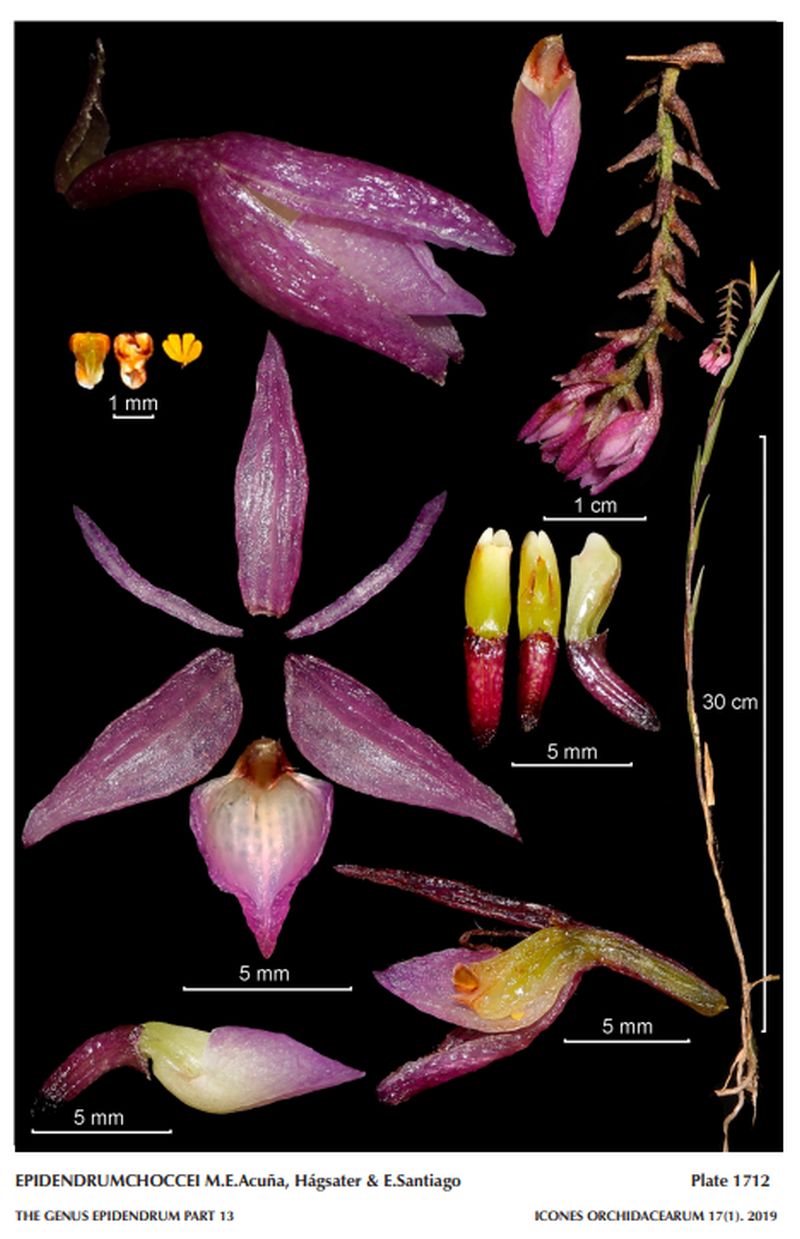

Epidendrum choccei M.E.Acuña, Hágsater & E.Santiago 2019 GROUP Frutex SUBGROUP Leptanthum
LCDP Photo J. D. Edquén & A. Cisneros/TYPE Photo by © J. D. Edquén and AMO Herbaria Website






Common Name Chocce's Epidendrum [Honors Peruvian botanist Miguel Chocce Peña (1977-2017), for his contributions to the knowledge of the orchid flora of Peru. He described 12 new orchid species and co-authored several papers with the authors. Miguel, also participated in the creation of five private conservation areas in Amazonas, all with a high diversity of orchids]
Flower Size .2" [.5 cm]
Found in north-eastern to central Peru, where it grows both in elfin forest and Andean tepui vegetation in shrub patches at elevations of 2850 to 3776 as a medium sized, cold growing terrestrial and occasionally as an epiphyte with cane-like, terete, scarcely branching above, branches 8.8 to 12" x .6 to .8" [22 to 30 × 0.15 to 0.20 cm], the first 3 to 4 internodes covered by leafless sheaths and carrying 17 to 19 on primary stem, distributed throughout, erect, parallel to the stem, at flowering the upper half present; 13 to 15 leaves on the branches; tubular, rugose; blade narrowly lanceolate, acute, coriaceous, margin finely crenulate, spreading when fresh, margin strongly revolute when dry leaves that blooms at most any time of the year on a terminal, without a spathe, peduncle .44 x .08" [11 × 2 mm], short, thin but not thread-like, with a large flat bract near the middle, .44 x .08" [11 × 2 mm], 2.4 to 4" [6 to 10 cm] long overall, apical, racemose to paniculate, arching-nutant, can produce new racemes even when the previous raceme is still in flower, successive developing together with the rachis, 2 to 4 open at once, 19 per raceme, many flowered inflorescence with progressively shorter, triangular, acuminate, shorter than the ovary, embracing floral bracts and carrying deep pink (fuchsia) colored flowers with the lip always turned towards the rachis, fleshy, disc of the lip white, column white at apex, green towards the base; without fragrance.
"Epidendrum choccei belongs to the GROUP Frutex recognized by the caepitose habit, usually simple stems, lanceolate leaves, lacking spathes, nutant racemes, widely cordiform to reniform lip and SUBGROUP Leptanthum which is caracterized by the thin stems, sparsely branched when mature, leaves short, linear-lanceolate to lanceolate oblong, nearly parallel to the stem, inflorescence arching-nutant, apical and lateral in mature stems, racemose to paniculate, few-flowered. The species is recognized by the narrowly lanceolate leaves flat, 1.08" to 1.6" x .12 to .24" [27 to 40 × 3 to 6 mm], parallel to the stem, flowers fucsia-rose colored, disc of the lip white, sepals .332 x .08 to .94" [8.3 x 2.0 to 2.3 mm], narrowly elliptic to semiovate-lanceolate, acuminate, lip .22 x .24" [5.5 x 6.0 mm], widely ovate the base truncate, apex acuminate. Epidendrum podocarpense Hágsater & E.Santiago is vegetatively similar, but the leaves larger, flat, 1.4 to 2.2" x .24 to .32" [35 to 55 x 6 to 8 mm], flowers fucsia, with the disc of the lip white, sepals .32 to .332" x .12 to .16" [8.0 to 8.3 x 3.0 to 4.0 mm], elliptic to narrowly elliptic, acute, lip .24 x .36" [6 x 9 mm], widely cordiform, base cordate, apex rounded. Epidendrum leptanthum Hágsater is vegetatively similar, leaves are 1.04 to 3.2" x .16 to .28" [26 to 80 x 4 to 7 mm], flowers greenish white, dorsally tinged reddish brown, sepals are oblong to ovate-oblong, acute, lip .24 x .28" [6 x 7 mm], widely cordiform, base cordate and apex acute. Epidendrum effusipetalum Hágsater, Edquén & E.Santiago has leaves 1.28 to 1.8" x .24 to .32" [32 to 45 x 6 to 8 mm], flowers greenish yellow, sepals tinged brown, sepals .34 to .42" x .196 to .2" [8.5 to 10.5 x 4.8 to 5.0 mm], triangular-lanceolate to triangular ovate, obtuse to acute, lip .26 x .28" [6.5 x 7 mm], ovate cordiform, apex rounded." Hagsater etal 2019
SynonymsReferences W3 Tropicos, Kew Monocot list , IPNI ; Icones Orchidacearum 16[2] Plate 1673 Hagsater & Sanchez 2018 see recognition section; Icones Orchidacearum 16[2] Plate 1677 Hagsater & Sanchez 2018 see recognition section; Icones Orchidacearum 16[2] Plate 1696 Hagsater & Sanchez 2018 see recognition section; Icones Orchidacearum 17(1) Plate 1712 Hagsater & Jimenez 2019 drawing/photo fide
--------------------------------------------------------------------------------------------------------------------------